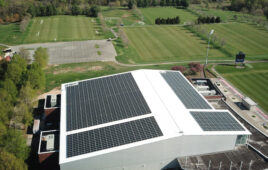Solar PV electricity costs have fallen 73% since 2010, according to a new cost analysis from the International Renewable Energy Agency (IRENA). Furthermore, solar PV costs are expected to be cut in half by 2020. The best solar PV projects could be delivering electricity for an equivalent of three cents per kWh or less within the next two years.
Global weighted average costs over the last 12 months for solar PV now stand at six cents and 10 cents per kWh respectively, with recent auction results suggesting future projects will significantly undercut these averages.The current cost spectrum for fossil fuel power generation ranges from five to 17 cents per kWh.
“This new dynamic signals a significant shift in the energy paradigm,” said Adnan Z. Amin, IRENA firector-general. “These cost declines across technologies are unprecendented and representative of the degree to which renewable energy is disrupting the global energy system.”
Released on the first day of IRENA’s Eighth Assembly in Abu Dhabi, Renewable Power Generation Costs in 2017 highlights that other forms of renewable power generation, such as bioenergy, geothermal and hydropower projects in the last 12 months have competed head-to-head on costs, with power from fossil fuels. The findings note that by 2019, the best onshore wind and solar PV projects will be delivering electricity significantly below the current cost of power from fossil fuels.
Competitive procurement practices together with the emergence of a large base of experienced medium-to-large project developers competing for global market opportunities, are cited as new drivers of recent cost reductions, in addition to continued technology advancements.
“Turning to renewables for new power generation is not simply an environmentally conscious decision, it is now – overwhelmingly – a smart economic one,” said Amin. “Governments around the world are recognizing this potential and forging ahead with low-carbon economic agendas underpinned by renewables-based energy systems. We expect the transition to gather further momentum, supporting jobs, growth, improved health, national resilience and climate mitigation around the world in 2018 and beyond.”
The report also highlights that auction results are signaling that offshore wind and concentrating solar power projects commissioned in the period between 2020 and 2022 will cost in the range of six to 10 cents per kWh, supporting accelerated deployment globally. IRENA projects that all renewable energy technologies will compete with fossils on price by 2020.
The report highlights that:
- The global weighted average levelised cost of electricity (LCOE) of utility-scale solar PV has fallen by 73% between 2010 and 2017 to 10 cents/kWh. .
- The average cost of electricity from onshore wind fell by 23% between 2010 and 2017. Projects are now routinely commissioned at four cents/kWh and the global weighted average is around six cents/kWh.
- By 2019, the best onshore wind and solar PV projects will be delivering electricity for an equivalent of three cents/kWh, or less. New bioenergy and geothermal projects commissioned in 2017 had global weighted average costs of around USD seven cents/kWh.
- Record low prices for solar PV in Abu Dhabi, Chile, Dubai, Mexico, Peru and Saudi Arabia have made three cents kWh (and below) the new benchmark.
- By 2020, project and auction data suggest that all currently commercialised renewable power generation technologies will be competing, and even undercutting, fossil fuels by generating in the range three to10 cents/kWh range.
The report was launched during the eighth IRENA Assembly, which welcomes more than 1,100 representatives of governments from 150 countries. As the world’s principal platform for international cooperation on renewable energy, the Assembly provides strategic guidance to the work of the Agency for the next four years and positions it to play a key role in driving the global energy transformation. See the report’s Executive Summary and the full report.
News item from IRENA




“Record low prices for solar PV in Abu Dhabi, Chile, Dubai, Mexico, Peru and Saudi Arabia have made three cents kWh (and below) the new benchmark.”
This price point has already been broken, now the up and coming flow battery utility sized storage solutions are forcing a change in the way electricity is generated, (stored), and distributed. Stacked grid functions like, storage of energy for arbitration, time of use, energy shifting, grid smoothing and frequency regulation make these energy storage systems more valuable than fueled generation plants.
Now it is of umost importance that we pay attention to storage. As a lecturet in systems conception, i do not see any problem on energy.
I would exchange with students and developpers.
All the best